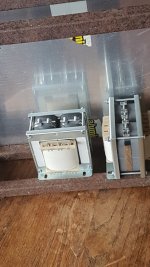If we define "dampened" as at least critically dampened, there must be no overshoot.Damped does not necessarily mean zero overshoot. It can also mean an overshoot that quickly decays to zero. There are degrees of damping.
Underdamped, critically damped, and overdamped exist on a continuum. All are damped to a greater or lesser degree. But enough wordplay... ;-)
I am back to the idea that a little ringing sounds better...one can always add an RC to compensate. It probably needs empirical optimization but I like the option.
I think we should distinguish between "ringing" and "overshoot." To me, ringing means an exaggerated and prolonged ripple on the top of the square wave, and indicates poor high-frequency control leading to possible instability. As magz says, a well damped square wave with a little overshoot at the leading edge is not an indication of instability. I always aim for a little overshoot at the leading edge, it can improve rise time a little bit and produces a better sound.


In audio transformers I think that ringing and overshoot are always related, because the situation is about the amount of dampening the RLC resonances of the transformer, produced by differently interconnected winding capacitance and leakage inductance. Dampening always reduces ringing and overshoot. However a transformer has multiple resonances, both series and parallel RLC circuits, and dampening one of them can worsen another. For example, dip (parallel) resonances get worse with loading, whereas series (peaking) resonances improve.
High ringing transformers have higher leakage inductance to driving impedance ratio with an incorrect placement of, too much capacitance, or both. High Ls transformers are much more critical to capacitance distribution considering the interleaving design and potentially, the shunt capacitance value connected to the secondary. Good example are step-up interstage transformers.
High ringing transformers have higher leakage inductance to driving impedance ratio with an incorrect placement of, too much capacitance, or both. High Ls transformers are much more critical to capacitance distribution considering the interleaving design and potentially, the shunt capacitance value connected to the secondary. Good example are step-up interstage transformers.
A tangent about tuning them out: On the aforementioned currently not working 845 amps, there were little networks on some extra windings as the unit was built when I got it. NOTHING else about the build seemed like a good idea. 4 stages of unsafe with a very marginal power supply. AC heaters. It had been running VERY hot with crispy wires and a super sketchy umbilical. Why in the context of all that the builder thought it important to toss an RC network on the outputs, presumably for this very reason, though likely to a greater degree ....
Because of the risk of finding a cure worse than the disease, I'm not inclined to mess with it. It seems to be awfully high in frequency and low in amplitude. It "settles" fast compared to the others. Maybe I'm too simple minded.
Paul
Because of the risk of finding a cure worse than the disease, I'm not inclined to mess with it. It seems to be awfully high in frequency and low in amplitude. It "settles" fast compared to the others. Maybe I'm too simple minded.
Paul
- Home
- Amplifiers
- Tubes / Valves
- 5k SE Transformer Tests: Monolith, Edcor, Antek, and Tamradio

